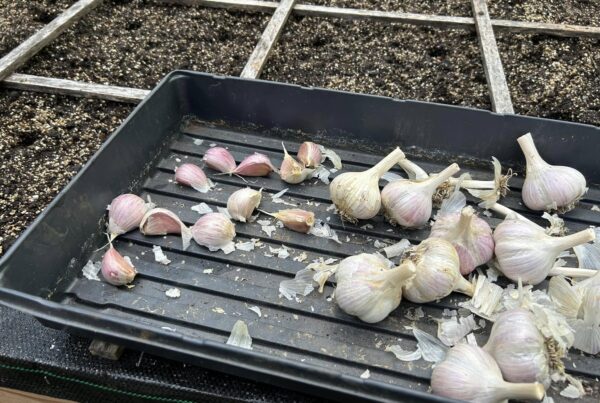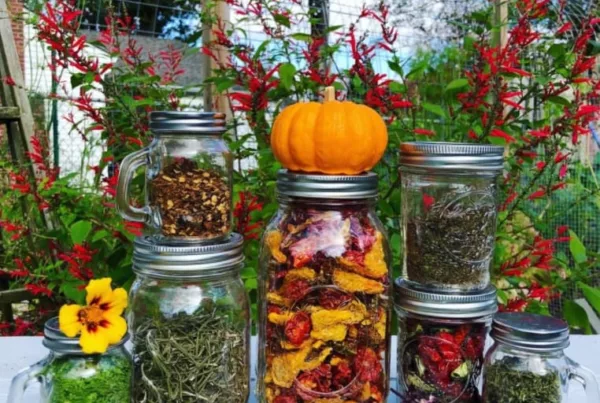Written by Kristina Hicks-Hamblin
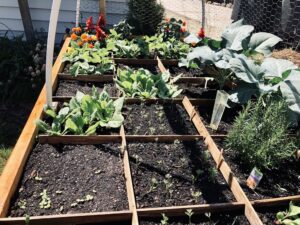 Rotating crops is an important practice for the Square Foot Garden. It’s like playing musical chairs with your veggies, but in this version of the game, everyone gets a new seat – or in this case, a new section of the grid!
Rotating crops is an important practice for the Square Foot Garden. It’s like playing musical chairs with your veggies, but in this version of the game, everyone gets a new seat – or in this case, a new section of the grid!
Crop rotation, or growing the same vegetable in the same location only once every three or four years, can help reduce problems with pests and diseases.
If you’ve heard of this technique but aren’t sure how to do it with your raised beds, read on for guidance.
Why You Should Rotate Crops
One of the reasons Square Foot Garden beds are grown with polycultures (that’s to say, a mix of different types of vegetables) is to keep plants healthier. Growing a raised garden box with a diverse array of members makes it harder for both insects and plant diseases to spread from square to square.
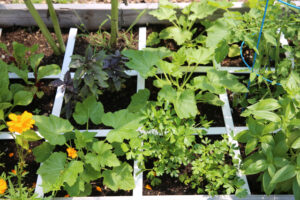
A diverse, polyculture bed
Crop rotation ensures this diversity in the garden, but across space and time.
For instance, if you had a flea beetle problem with your kale this year, growing more kale in the same spot next year can worsen the problem since flea beetles can overwinter in the soil.
Instead, re-plant with a totally different type of vegetable that isn’t prone to flea beetles, and those little pests will move on or die out. Growing a diverse sequence of veggies will make things less inviting for these unwanted guests.
Take Notes on Your Plantings
Now that you understand the importance of moving things around in your beds, let’s address a practical matter. If you want to switch out your garden selections, you need to know what you grew previously!
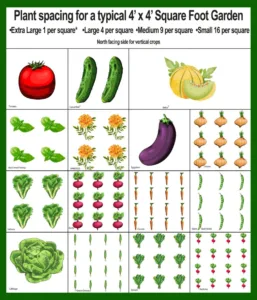 If you have a photographic memory and don’t need to write things down – I rest in admiration. However, those of us without such a gift will benefit from taking notes, and a dedicated notebook is an especially handy tool for this.
If you have a photographic memory and don’t need to write things down – I rest in admiration. However, those of us without such a gift will benefit from taking notes, and a dedicated notebook is an especially handy tool for this.
So, try keeping a notebook with “maps” of your raised bed – and don’t worry, your designs don’t have to be works of art. Sketch out a drawing of your box, divide it into sixteen equal squares, and label each square with what you’ve planted. Grid paper will make this task even easier.
Alternatively, you might want to use our plant spacing chart. It comes with a blank planning sheet that you can use to map out your own Square Foot Garden beds.
Download the plant spacing chart here – it’s free!
Each time you sow or transplant a veggie into the box, make a note. When a new year of growing begins, make a new drawing and label it accordingly. This way you can look back at previous years’ plantings and avoid growing the same crop or plant family in the square for the next two or three years.
Think in Plant Families
Now that you have a way of tracking your raised bed plantings, you’ll want to take a quick dip into “Botany 101” and learn to recognize a few botanical families.
That’s because members of the same family tend to be vulnerable to the same pests and diseases, so it’s not enough to alternate individual veggies. We also need to cycle crop families.
Here are some of the most common garden veggie families and some of their members:

Having multiple beds makes alternating even easier.
- Allium family: Garlic, onions, leeks, chives, shallots.
- Amaranth family: Amaranth, beets, spinach, Swiss chard.
- Aster family: Lettuce, sunflowers.
- Brassicas, or cruciferous family: Broccoli, cauliflower, radishes, cabbage, bok choy, kale, collards, brussels sprouts, mustard greens, arugula, kohlrabi, turnips.
- Cucurbit family: Cucumbers, melons, pumpkins, squash, zucchini.
- Legume family: Beans, cowpeas, chick peas, fava beans, peas.
- Nightshade family: Tomatoes, peppers, eggplant, potatoes, tomatillos, ground cherries.
- Parsley family: Carrots, parsnips, fennel, dill, cilantro, parsley.
Swap Crops at Each New Planting
Now that you have a tool for tracking plantings and a way to group veggies into families, it will be much easier to alternate garden produce in your boxes: simply choose different families for a given square for the next three to four years. Wondering how often to swap crops? Do so each time you re-plant a grid square – that means at least every year, and preferably every time you sow or transplant a succession of new veggies.

After harvesting radishes, I’m sowing peas next. Photo credits to Kristina.
If you’re re-sowing any grid sections in anticipation of fall, this is also the perfect time to play another round of musical chairs. While alternating vegetables among squares is a good place to start, you may also want to cycle raised beds.
For instance, if you are growing a salsa garden (with tomatoes, peppers, and tomatillos) in one of your boxes this year, consider using that same bed for a salad garden (with lettuce, radishes, cauliflower, arugula, and peas) next year.
Now that you know how and why to rotate the grids in your raised bed, it should feel as fun as a game!

